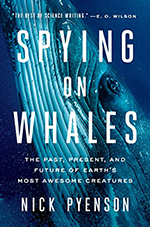2 April 2019
Spying on Whales, by Nick Pyenson
Posted by Callan Bentley
 The latest book that I listened to was Spying on Whales, by the Smithsonian’s Nick Pyenson. Nick is a paleontologist at the National Museum of Natural History, but he doesn’t limit his professional work to dusty bones. Lucky for him, the object of his fascination, rorqual whales, are not only present in stratified sedimentary rocks, but can also be found swimming in the world ocean today. The book opens in Antarctica, tagging living, breathing modern whales in hopes of learning more about their lives deep below the surface.
The latest book that I listened to was Spying on Whales, by the Smithsonian’s Nick Pyenson. Nick is a paleontologist at the National Museum of Natural History, but he doesn’t limit his professional work to dusty bones. Lucky for him, the object of his fascination, rorqual whales, are not only present in stratified sedimentary rocks, but can also be found swimming in the world ocean today. The book opens in Antarctica, tagging living, breathing modern whales in hopes of learning more about their lives deep below the surface.
But that’s just an opener. The meat of the text begins as he describes the revelation of Cerro Ballena in Chile’s Atacama Desert, and how 3D scanning allowed the capture of critical information from the site as the site’s doom was impending. The stories of field work like this are a real strength of the book – hearing the circumstances under which Pyenson grapples with challenges, priorities, and personalities in order to make science happen. Another strength is the constant presence of Science (with a capital S) as the guiding force for his work – the reader gets frequent reminders of the larger, over-arching philosophical drives that push the actions of scientists on the ground.
Pyenson is also responsible for the discovery of a sensory organ in the “chin” tip of the lower jaw that helps these huge animals coordinate lunge-feeding maneuvers. This is a pretty huge deal – a new organ! – and he made it in a flensing & rendering facility for an Icelandic whaling company, using equipment including “the world’s biggest deli slicer” (ewwwww).
He discusses work in the Smithsonian’s terrific collections, sequestered in the museum or in off-site storage facilities, one of which holds the largest individual bones known: the jaws of a blue whale killed early last century. One of my favorite parts of the book is using these objects as prompts for thinking about whales’ long life spans, and the history that individual whales have seen. His story about a bowhead whale that saw Franklin’s ill-fated Northwest Passage expedition and survives two centuries to be harvested by modern Inupiat people is quite compelling. His exploration of the reasons for whale gigantism are also impressive – this is a modern feature of whales, not an ancient one: it only happened in the last 10% of their collective history as a group. Pyenson presents a case for the Ice Ages being the cause.
Spying on Whales is organized roughly into “past, present, and future,” which is to say his work on paleontology, his work on modern whales (such as the chin organ), and finally a glimpse into the Anthropocene future, which combines both a profound sense of the human-induced changes to the whales’ habitat in the past couple of centuries, as well as insights into whale evolution happening today.
Overall, it’s a fascinating book, well-written and well-felt, and I enjoyed it. Recommended!


 Callan Bentley is Associate Professor of Geology at Piedmont Virginia Community College in Charlottesville, Virginia. He is a Fellow of the Geological Society of America. For his work on this blog, the National Association of Geoscience Teachers recognized him with the James Shea Award. He has also won the Outstanding Faculty Award from the State Council on Higher Education in Virginia, and the Biggs Award for Excellence in Geoscience Teaching from the Geoscience Education Division of the Geological Society of America. In previous years, Callan served as a contributing editor at EARTH magazine, President of the Geological Society of Washington and President the Geo2YC division of NAGT.
Callan Bentley is Associate Professor of Geology at Piedmont Virginia Community College in Charlottesville, Virginia. He is a Fellow of the Geological Society of America. For his work on this blog, the National Association of Geoscience Teachers recognized him with the James Shea Award. He has also won the Outstanding Faculty Award from the State Council on Higher Education in Virginia, and the Biggs Award for Excellence in Geoscience Teaching from the Geoscience Education Division of the Geological Society of America. In previous years, Callan served as a contributing editor at EARTH magazine, President of the Geological Society of Washington and President the Geo2YC division of NAGT.
I like this.